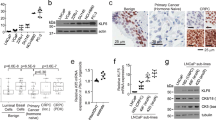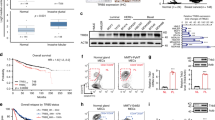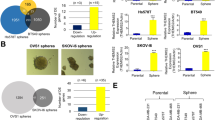Abstract
Whereas accumulating studies have supported the cancer stem cell theory, a specific therapy targeting a cancer stem cell subpopulation has not been established. Here, we show that dual-specificity tyrosine phosphorylation-kinase 2 (DYRK2) is a novel negative regulator for formation of breast cancer stem cells. Downregulation of DYRK2 promotes cancer stem-like traits in vitro, tumourigenesis in vivo and the proportion of the cancer stem cell population in human breast cancer tissues. We found that Krupple-like factor 4 (KLF4) serves as a key mediator of DYRK2’s control over the cancer stem phenotype. Reduced DYRK2 expression increases KLF4 expression, which induces cancer stem-like properties. We identified androgen receptor (AR) as a transcription factor binding to the KLF4 promoter region; this process is dependent on DYRK2 kinase activity. Our findings delineate a mechanism of cancer stem cell regulation by the DYRK2–AR–KLF4 axis in breast cancer. Targeting of this pathway may be a promising strategy against breast cancer stem cells.
This is a preview of subscription content, access via your institution
Access options
Subscribe to this journal
Receive 50 print issues and online access
$259.00 per year
only $5.18 per issue
Buy this article
- Purchase on Springer Link
- Instant access to full article PDF
Prices may be subject to local taxes which are calculated during checkout






Similar content being viewed by others
References
Al-Hajj M, Wicha MS, Benito-Hernandez A, Morrison SJ, Clarke MF . Prospective identification of tumorigenic breast cancer cells. Proc Natl Acad Sci USA 2003; 100: 3983–3988.
Takahashi K, Yamanaka S . Induction of pluripotent stem cells from mouse embryonic and adult fibroblast cultures by defined factors. Cell 2006; 126: 663–676.
Wei Z, Yang Y, Zhang P, Andrianakos R, Hasegawa K, Lyu J et al. Klf4 interacts directly with Oct4 and Sox2 to promote reprogramming. Stem Cells 2009; 27: 2969–2978.
Pandya AY, Talley LI, Frost AR, Fitzgerald TJ, Trivedi V, Chakravarthy M et al. Nuclear localization of KLF4 is associated with an aggressive phenotype in early-stage breast cancer. Clin Cancer Res 2004; 10: 2709–2719.
Foster KW, Liu Z, Nail CD, Li X, Fitzgerald TJ, Bailey SK et al. Induction of KLF4 in basal keratinocytes blocks the proliferation-differentiation switch and initiates squamous epithelial dysplasia. Oncogene 2005; 24: 1491–1500.
Morel AP, Lievre M, Thomas C, Hinkal G, Ansieau S, Puisieux A . Generation of breast cancer stem cells through epithelial-mesenchymal transition. PLoS ONE 2008; 3: e2888.
Thiery JP, Acloque H, Huang RY, Nieto MA . Epithelial-mesenchymal transitions in development and disease. Cell 2009; 139: 871–890.
Yu F, Li J, Chen H, Fu J, Ray S, Huang S et al. Kruppel-like factor 4 (KLF4) is required for maintenance of breast cancer stem cells and for cell migration and invasion. Oncogene 2011; 30: 2161–2172.
Aranda S, Laguna A, de la Luna S . DYRK family of protein kinases: evolutionary relationships, biochemical properties, and functional roles. FASEB J 2011; 25: 449–462.
Taira N, Nihira K, Yamaguchi T, Miki Y, Yoshida K . DYRK2 is targeted to the nucleus and controls p53 via Ser46 phosphorylation in the apoptotic response to DNA damage. Mol Cell 2007; 25: 725–738.
Mimoto R, Taira N, Takahashi H, Yamaguchi T, Okabe M, Uchida K et al. DYRK2 controls the epithelial-mesenchymal transition in breast cancer by degrading Snail. Cancer Lett 2013; 339: 214–225.
Yamaguchi N, Mimoto R, Yanaihara N, Imawari Y, Hirooka S, Okamoto A et al. DYRK2 regulates epithelial-mesenchymal-transition and chemosensitivity through Snail degradation in ovarian serous adenocarcinoma. Tumour Biol 2015; 36: 5913–5923.
Jung HY, Wang X, Jun S, Park JI . Dyrk2-associated EDD-DDB1-VprBP E3 ligase inhibits telomerase by TERT degradation. J Biol Chem 2013; 288: 7252–7262.
Hiyama E, Hiyama K . Telomere and telomerase in stem cells. Br J Cancer 2007; 96: 1020–1024.
Mani SA, Guo W, Liao MJ, Eaton EN, Ayyanan A, Zhou AY et al. The epithelial-mesenchymal transition generates cells with properties of stem cells. Cell 2008; 133: 704–715.
Shipitsin M, Campbell LL, Argani P, Weremowicz S, Bloushtain-Qimron N, Yao J et al. Molecular definition of breast tumor heterogeneity. Cancer Cell 2007; 11: 259–273.
Marinescu VD, Kohane IS, Riva A . The MAPPER database: a multi-genome catalog of putative transcription factor binding sites. Nucleic Acids Res 2005; 33: D91–D97.
Bolton EC, So AY, Chaivorapol C, Haqq CM, Li H, Yamamoto KR . Cell- and gene-specific regulation of primary target genes by the androgen receptor. Genes Dev 2007; 21: 2005–2017.
Tomaskovic-Crook E, Thompson EW, Thiery JP . Epithelial to mesenchymal transition and breast cancer. Breast Cancer Res 2009; 11: 213.
Chen X, Whitney EM, Gao SY, Yang VW . Transcriptional profiling of Kruppel-like factor 4 reveals a function in cell cycle regulation and epithelial differentiation. J Mol Biol 2003; 326: 665–677.
Li R, Liang J, Ni S, Zhou T, Qing X, Li H et al. A mesenchymal-to-epithelial transition initiates and is required for the nuclear reprogramming of mouse fibroblasts. Cell Stem Cell 2010; 7: 51–63.
Yori JL, Seachrist DD, Johnson E, Lozada KL, Abdul-Karim FW, Chodosh LA et al. Kruppel-like factor 4 inhibits tumorigenic progression and metastasis in a mouse model of breast cancer. Neoplasia 2011; 13: 601–610.
Choi BJ, Cho YG, Song JW, Kim CJ, Kim SY, Nam SW et al. Altered expression of the KLF4 in colorectal cancers. Pathol Res Pract 2006; 202: 585–589.
Wei D, Gong W, Kanai M, Schlunk C, Wang L, Yao JC et al. Drastic down-regulation of Kruppel-like factor 4 expression is critical in human gastric cancer development and progression. Cancer Res 2005; 65: 2746–2754.
Rowland BD, Bernards R, Peeper DS . The KLF4 tumour suppressor is a transcriptional repressor of p53 that acts as a context-dependent oncogene. Nat Cell Biol 2005; 7: 1074–1082.
Taira N, Mimoto R, Kurata M, Yamaguchi T, Kitagawa M, Miki Y et al. DYRK2 priming phosphorylation of c-Jun and c-Myc modulates cell cycle progression in human cancer cells. J Clin Invest 2012; 122: 859–872.
Enomoto Y, Yamashita S, Yoshinaga Y, Fukami Y, Miyahara S, Nabeshima K et al. Downregulation of DYRK2 can be a predictor of recurrence in early stage breast cancer. Tumour Biol 2014; 35: 11021–11025.
Nomura S, Suzuki Y, Takahashi R, Terasaki M, Kimata R, Terasaki Y et al. Dual-specificity tyrosine phosphorylation-regulated kinase 2 (DYRK2) as a novel marker in T1 high-grade and T2 bladder cancer patients receiving neoadjuvant chemotherapy. BMC Urol 2015; 15: 53.
Wang Y, Wu Y, Miao X, Zhu X, Miao X, He Y et al. Silencing of DYRK2 increases cell proliferation but reverses CAM-DR in non-Hodgkin’s lymphoma. Int J Biol Macromol 2015; 81: 809–817.
Yamashita S, Chujo M, Moroga T, Anami K, Tokuishi K, Miyawaki M et al. DYRK2 expression may be a predictive marker for chemotherapy in non-small cell lung cancer. Anticancer Res 2009; 29: 2753–2757.
Wingender E, Chen X, Hehl R, Karas H, Liebich I, Matys V et al. TRANSFAC: an integrated system for gene expression regulation. Nucleic Acids Res 2000; 28: 316–319.
Taira N, Yamaguchi T, Kimura J, Lu ZG, Fukuda S, Higashiyama S et al. Induction of amphiregulin by p53 promotes apoptosis via control of microRNA biogenesis in response to DNA damage. Proc Natl Acad Sci U S A 2014; 111: 717–722.
Mimoto R, Kobayashi T, Imawari Y, Kamio M, Kato K, Nogi H et al. Clinical relevance and low tumor-initiating properties of oligometastatic breast cancer in pulmonary metastasectomy. Breast Cancer Res Treat 2014; 147: 317–324.
Acknowledgements
The authors appreciate all patients who provided the clinical samples for the study. We thank Naoe T Nihira for microarray analysis, Mamiko Owada for immunohistochemistry, Minori Kamada for FACS analysis and Noriko Yamaguchi for xenograft experiments. This work was supported by grants from JSPS KAKENHI Grant Number 26290041 and 26861056, Takeda Science Foundation, the Vehicle Racing Commemorative Foundation and Research Grant of the Princess Takamatsu Cancer Research Fund.
Author contributions
RM and KY designed the research. RM and YI performed the research. SH analyzed the immunohistochemistry. HT provided the breast cancer specimens and analyzed clinical data. KY supervised the research. RM, YI and KY wrote the manuscript.
Author information
Authors and Affiliations
Corresponding author
Ethics declarations
Competing interests
The authors declare no conflict of interest.
Additional information
Supplementary Information accompanies this paper on the Oncogene website
Rights and permissions
About this article
Cite this article
Mimoto, R., Imawari, Y., Hirooka, S. et al. Impairment of DYRK2 augments stem-like traits by promoting KLF4 expression in breast cancer. Oncogene 36, 1862–1872 (2017). https://doi.org/10.1038/onc.2016.349
Received:
Revised:
Accepted:
Published:
Issue Date:
DOI: https://doi.org/10.1038/onc.2016.349
This article is cited by
-
A novel CDC25A/DYRK2 regulatory switch modulates cell cycle and survival
Cell Death & Differentiation (2022)
-
A pan-cancer analysis of the oncogenic role of dual-specificity tyrosine (Y)-phosphorylation- regulated kinase 2 (DYRK2) in human tumors
Scientific Reports (2022)
-
DYRK2 controls a key regulatory network in chronic myeloid leukemia stem cells
Experimental & Molecular Medicine (2020)
-
Updating dual-specificity tyrosine-phosphorylation-regulated kinase 2 (DYRK2): molecular basis, functions and role in diseases
Cellular and Molecular Life Sciences (2020)



